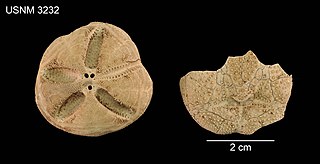
The forest raven, also commonly known as the Tasmanian raven, is a passerine bird in the family Corvidae native to Tasmania and parts of southern Victoria, such as Wilsons Promontory and Portland. Populations are also found in parts of New South Wales, including Dorrigo and Armidale. Measuring 50–53 cm (20–21 in) in length, it has all-black plumage, beak and legs. As with the other two species of raven in Australia, its black feathers have grey bases. Adults have white irises; younger birds have dark brown and then hazel irises with an inner blue rim. New South Wales populations are recognised as a separate subspecies C. tasmanicus boreus, but appear to be nested within the Tasmanian subspecies genetically.

The Aspidodiadematidae are a family of sea urchins.

Hans Kroh was a German paratroop general in the Wehrmacht and Bundeswehr and a recipient of the Knight's Cross of the Iron Cross with Oak Leaves and Swords of Nazi Germany.
The World Register of Marine Species (WoRMS) is a taxonomic database that aims to provide an authoritative and comprehensive list of names of marine organisms.

The Echinacea are a superorder of sea urchins. They are distinguished by the presence of a rigid test, with ten buccal plates around the mouth, and solid spines. Unlike some other sea urchins, they also possess gills. The group is a large one, with species found worldwide.

The Camarodonta are an order of globular sea urchins in the class Echinoidea. The fossil record shows that camarodonts have been in existence since the Lower Cretaceous.

Abatus cordatus is a species of sea urchin in the family Schizasteridae. It is native to shallow seas surrounding certain island groups in the southern Indian Ocean. The body is protected by a hard test or shell which is covered with spines. The female broods its young in deep pockets on the upper surface, retaining the young in place with specialised spines. American zoologist Addison Emery Verrill first scientifically described A. cordatus in 1876.

Araeolampas atlantica is a species of sea urchin of the family Loveniidae. Their armour is covered with spines. It is placed in the genus Arachnoides and lives in the sea. Araeolampas atlantica was first scientifically described in 1974 by K. Serafy.
Austrocidaris pawsoni is a species of sea urchins of the Family Cidaridae. Their armour is covered with spines. Austrocidaris pawsoni was first scientifically described in 1974 by McKnight.

Austrocidaris spinulosa is a species of sea urchins of the family Cidaridae. Their armour is covered with spines. Austrocidaris spinulosa was first scientifically described in 1910 by Ole Mortensen.
Breynia neanika is a species of sea urchins of the Family Loveniidae. Their armour is covered with spines. Breynia neanika was first scientifically described in 1982 by McNamara.

Brisaster antarcticus is a species of sea urchins of the family Schizasteridae. Their armour is covered with spines. Brisaster antarcticus was first scientifically described in 1906 by Döderlein.
Brisaster fragilis is a species of sea urchins of the family Schizasteridae. Their armour is covered with spines. Brisaster fragilis was first scientifically described in 1844 by Düben & Koren.
Brisaster kerguelenensis is a species of sea urchins of the family Schizasteridae. Their armour is covered with spines. Brisaster kerguelenensis was first scientifically described in 1917 by Hubert Lyman Clark.

Brisaster latifrons is a species of sea urchins of the family Schizasteridae. Their armour is covered with spines. Brisaster latifrons was first scientifically described in 1898 by Alexander Emanuel Agassiz.
Brisaster owstoni is a species of sea urchins of the family Schizasteridae. Their armour is covered with spines. Brisaster owstoni was first scientifically described in 1950 by Ole Theodor Jensen Mortensen.
Brisaster townsendi is a species of sea urchins of the family Schizasteridae. Their armour is covered with spines. Brisaster townsendi was first scientifically described in 1898 by Alexander Emanuel Agassiz.
Brissalius vannoordenburgi is a species of sea urchin in the Family Brissidae. Their armour is covered with spines. Brissalius vannoordenburgi was first scientifically described in 2008 by Coppard.
Caenopedina otagoensis is a species of sea urchins of the Family Pedinidae. Their armour is covered with spines. Caenopedina otagoensis was first scientifically described in 1968 by McKnight.
Brisaster is a genus of echinoderms belonging to the family Schizasteridae.










